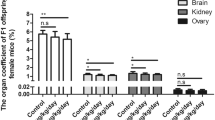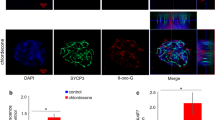Abstract
Bisphenol A (BPA), a synthetic additive used to harden polycarbonate plastics and epoxy resin, is ubiquitous in our everyday environment. Many studies have indicated detrimental effects of BPA on the mammalian reproductive abilities. This study is aimed to test the potential effects of BPA on methylation of imprinted genes during oocyte growth and meiotic maturation in CD-1 mice. Our results demonstrated that BPA exposure resulted in hypomethylation of imprinted gene Igf2r and Peg3 during oocyte growth, and enhanced estrogen receptor (ER) expression at the levels of mRNA and protein. The relationship between ER expression and imprinted gene hypomethylation was substantiated using an ER inhibitor, ICI182780. In addition, BPA promoted the primordial to primary follicle transition, thereby speeding up the depletion of the primordial follicle pool, and suppressed the meiotic maturation of oocytes because of abnormal spindle assembling in meiosis I. In conclusion, neonatal exposure to BPA inhibits methylation of imprinted genes during oogenesis via the ER signaling pathway in CD-1 mice.






Similar content being viewed by others
References
Anway MD, Cupp AS, Uzumcu M, Skinner MK (2005) Epigenetic transgenerational actions of endocrine disruptors and male fertility. Science 308:1466–1469
Bourc’his D, Xu GL, Lin CS, Bollman B, Bestor TH (2001) Dnmt3L and the establishment of maternal genomic imprints. Science 294:2536–2539
Bouskine A, Nebout M, Brucker-Davis F, Benahmed M, Fenichel P (2009) Low doses of bisphenol A promote human seminoma cell proliferation by activating PKA and PKG via a membrane G-protein-coupled estrogen receptor. Environ Health Perspect 117:1053–1058
Bromer JG, Zhou Y, Taylor MB, Doherty L, Taylor HS (2010) Bisphenol-A exposure in utero leads to epigenetic alterations in the developmental programming of uterine estrogen response. FASEB J 24:2273–2280
Brotons JA, Olea-Serrano MF, Villalobos M, Pedraza V, Olea N (1995) Xenoestrogens released from lacquer coatings in food cans. Environ Health Perspect 103:608–612
Calafat AM, Kuklenyik Z, Reidy JA, Caudill SP, Ekong J, Needham LL (2005) Urinary concentrations of bisphenol A and 4-nonylphenol in a human reference population. Environ Health Perspect 113:391–395
Can A, Semiz O, Cinar O (2005) Bisphenol-A induces cell cycle delay and alters centrosome and spindle microtubular organization in oocytes during meiosis. Mol Hum Reprod 11:389–396
Dolinoy DC, Huang D, Jirtle RL (2007) Maternal nutrient supplementation counteracts bisphenol A-induced DNA hypomethylation in early development. Proc Natl Acad Sci USA 104:13056–13061
Eichenlaub-Ritter U, Vogt E, Cukurcam S, Sun F, Pacchierotti F, Parry J (2008) Exposure of mouse oocytes to bisphenol A causes meiotic arrest but not aneuploidy. Mutat Res 651:82–92
George O, Bryant BK, Chinnasamy R, Corona C, Arterburn JB, Shuster CB (2008) Bisphenol A directly targets tubulin to disrupt spindle organization in embryonic and somatic cells. ACS Chem Biol 3:167–179
Hall JM, McDonnell DP (2005) Coregulators in nuclear estrogen receptor action: from concept to therapeutic targeting. Mol Interv 5:343–357
Hata K, Okano M, Lei H, Li E (2002) Dnmt3L cooperates with the Dnmt3 family of de novo DNA methyltransferases to establish maternal imprints in mice. Development 129:1983–1993
Hiura H, Obata Y, Komiyama J, Shirai M, Kono T (2006) Oocyte growth-dependent progression of maternal imprinting in mice. Genes Cells 11:353–361
Ho SM, Tang WY, Belmonte de Frausto J, Prins GS (2006) Developmental exposure to estradiol and bisphenol A increases susceptibility to prostate carcinogenesis and epigenetically regulates phosphodiesterase type 4 variant 4. Cancer Res 66:5624–5632
Hunt PA, Koehler KE, Susiarjo M, Hodges CA, Ilagan A, Voigt RC, Thomas S, Thomas BF, Hassold TJ (2003) Bisphenol A exposure causes meiotic aneuploidy in the female mouse. Curr Biol 13:546–553
Ikezuki Y, Tsutsumi O, Takai Y, Kamei Y, Taketani Y (2002) Determination of bisphenol A concentrations in human biological fluids reveals significant early prenatal exposure. Hum Reprod 17:2839–2841
Kipp JL, Kilen SM, Woodruff TK, Mayo KE (2007) Activin regulates estrogen receptor gene expression in the mouse ovary. J Biol Chem 282:36755–36765
Krishnan AV, Stathis P, Permuth SF, Tokes L, Feldman D (1993) Bisphenol-A: an estrogenic substance is released from polycarbonate flasks during autoclaving. Endocrinology 132:2279–2286
La Salle S, Mertineit C, Taketo T, Moens PB, Bestor TH, Trasler JM (2004) Windows for sex-specific methylation marked by DNA methyltransferase expression profiles in mouse germ cells. Dev Biol 268:403–415
Lees-Murdock DJ, Shovlin TC, Gardiner T, De Felici M, Walsh CP (2005) DNA methyltransferase expression in the mouse germ line during periods of de novo methylation. Dev Dyn 232:992–1002
Li E, Beard C, Jaenisch R (1993) Role for DNA methylation in genomic imprinting. Nature 366:362–365
Li L, Keverne EB, Aparicio SA, Ishino F, Barton SC, Surani MA (1999) Regulation of maternal behavior and offspring growth by paternally expressed Peg3. Science 284:330–333
Li M, Li S, Yuan J, Wang ZB, Sun SC, Schatten H, Sun QY (2009) Bub3 is a spindle assembly checkpoint protein regulating chromosome segregation during mouse oocyte meiosis. PLoS ONE 4:e7701
Lutz LB, Cole LM, Gupta MK, Kwist KW, Auchus RJ, Hammes SR (2001) Evidence that androgens are the primary steroids produced by Xenopus laevis ovaries and may signal through the classical androgen receptor to promote oocyte maturation. Proc Natl Acad Sci USA 98:13728–13733
Maffini MV, Rubin BS, Sonnenschein C, Soto AM (2006) Endocrine disruptors and reproductive health: the case of bisphenol-A. Mol Cell Endocrinol 254–255:179–186
Nagel SC, vom Saal FS, Thayer KA, Dhar MG, Boechler M, Welshons WV (1997) Relative binding affinity-serum modified access (RBA-SMA) assay predicts the relative in vivo bioactivity of the xenoestrogens bisphenol A and octylphenol. Environ Health Perspect 105:70–76
Nakamura K, Itoh K, Yaoi T, Fujiwara Y, Sugimoto T, Fushiki S (2006) Murine neocortical histogenesis is perturbed by prenatal exposure to low doses of Bisphenol A. J Neurosci Res 84:1197–1205
Nakamura K, Itoh K, Sugimoto T, Fushiki S (2007) Prenatal exposure to bisphenol A affects adult murine neocortical structure. Neurosci Lett 420:100–105
Okano M, Bell DW, Haber DA, Li E (1999) DNA methyltransferases Dnmt3a and Dnmt3b are essential for de novo methylation and mammalian development. Cell 99:247–257
Pfeiffer E, Rosenberg B, Deuschel S, Metzler M (1997) Interference with microtubules and induction of micronuclei in vitro by various bisphenols. Mutat Res 390:21–31
Reik W, Walter J (2001) Genomic imprinting: parental influence on the genome. Nat Rev Genet 2:21–32
Robertson KD (2001) DNA methylation, methyltransferases, and cancer. Oncogene 20:3139–3155
Roy D, Palangat M, Chen CW, Thomas RD, Colerangle J, Atkinson A, Yan ZJ (1997) Biochemical and molecular changes at the cellular level in response to exposure to environmental estrogen-like chemicals. J Toxicol Environ Health 50:1–29
Schonfelder G, Wittfoht W, Hopp H, Talsness CE, Paul M, Chahoud I (2002) Parent bisphenol A accumulation in the human maternal–fetal–placental unit. Environ Health Perspect 110:A703–A707
Shovlin TC, Bourc’his D, La Salle S, O’Doherty A, Trasler JM, Bestor TH, Walsh CP (2007) Sex-specific promoters regulate Dnmt3L expression in mouse germ cells. Hum Reprod 22:457–467
Smith LD, Ecker RE (1971) The interaction of steroids with Rana pipiens oocytes in the induction of maturation. Dev Biol 25:232–247
Song Z, Min L, Pan Q, Shi Q, Shen W (2009) Maternal imprinting during mouse oocyte growth in vivo and in vitro. Biochem Biophys Res Commun 387:800–805
Stouder C, Paoloni-Giacobino A (2010) Transgenerational effects of the endocrine disruptor vinclozolin on the methylation pattern of imprinted genes in the mouse sperm. Reproduction 139:373–379
Surani MA (1998) Imprinting and the initiation of gene silencing in the germ line. Cell 93:309–312
Susiarjo M, Hassold TJ, Freeman E, Hunt PA (2007) Bisphenol A exposure in utero disrupts early oogenesis in the mouse. PLoS Genet 3:e5
Tanikawa M, Harada T, Mitsunari M, Onohara Y, Iwabe T, Terakawa N (1998) Expression of c-kit messenger ribonucleic acid in human oocyte and presence of soluble c-kit in follicular fluid. J Clin Endocrinol Metab 83:1239–1242
Uzumcu M, Zachow R (2007) Developmental exposure to environmental endocrine disruptors: consequences within the ovary and on female reproductive function. Reprod Toxicol 23:337–352
Vandenberg LN, Hauser R, Marcus M, Olea N, Welshons WV (2007) Human exposure to bisphenol A (BPA). Reprod Toxicol 24:139–177
Yamamoto T, Yasuhara A, Shiraishi H, Nakasugi O (2001) Bisphenol A in hazardous waste landfill leachates. Chemosphere 42:415–418
Yaoi T, Itoh K, Nakamura K, Ogi H, Fujiwara Y, Fushiki S (2008) Genome-wide analysis of epigenomic alterations in fetal mouse forebrain after exposure to low doses of bisphenol A. Biochem Biophys Res Commun 376:563–567
Zhang P, Chao H, Sun X, Li L, Shi Q, Shen W (2010) Murine folliculogenesis in vitro is stage-specifically regulated by insulin via the Akt signaling pathway. Histochem Cell Biol 134:75–82
Acknowledgments
This work was supported by grants from the National Basic Research Program of China (973 Program, 2012CB944401, 2011CB944501 and 2007CB947401), National Nature Science Foundation (31001010, 31171376 and 31101716), Foundation of Shandong Provincial Education Department (J11LC20), Foundation of Distinguished Young Scholars (JQ201109) and Foundation of Taishan Scholar of Shandong Province.
Conflict of interest
These authors fully declare any financial or other potential conflict of interest.
Author information
Authors and Affiliations
Corresponding author
Electronic supplementary material
Below is the link to the electronic supplementary material.
Materials and methods
The ovaries collected from Experiment 1 and Experiment 2 mice were fixed in 10% neutral formalin. Whole ovary slices were immunostained as previously described (Zhang et al., 2010). Immunohistochemistry was performed on the paraffin section of ovaries of PND 15 and PND 21 using an antibody against STAT3 (Santa Cruz Biotechnology sc-482, La Jolla, CA, USA) at a dilution of 1:200, and the nucleus was stained with hematoxylin. Slices were imaged under a Nikon inversion microscope. Different stages of follicles were counted. Oocytes with single-layer flat somatic cells were regarded as primordial follicles; oocytes with single-layer cubical somatic cells were regarded as primary follicles; and oocytes with multi-layer somatic cells were regarded as secondary follicles. The secondary follicles with follicular cavity were regarded as antral follicles, and the single follicle with multiple oocytes were regarded as multiple oocyte follicle (MOF).
DNA was isolated from ovarian granulose cells of 15 d or 21 d mice using a micro-DNA isolation kit (Tiangen). The isolated DNA was treated with sodium bisulfite with a MethylampTM DNA modification kit (Epigentek). The bisulfite-treated DNA was amplified by PCR for ER-α with primers: left, 5’-AAG ATG TT ATG GAG AGG GTT TTG-3’; right, 5’-AAA CCC CCA AAC TAT TAA CAC TAA AA-3’. The PCR products were separated by electrophoresis in 1% agarose gel, and the correct sized bands were isolated from the gel and purified with Wizard SV Gel and a PCR Clean-Up System (Promega). The purified DNA was cloned into a pMD18-T vector (TaKaRa). The positive clones were obtained by aminobenzylpenicillin selection and the insert was sequenced at GeneScript (Nanjing).
418_2011_894_MOESM2_ESM.ppt
Supplemental Figure 2. The immunohistochemistry analysis of the ovaries from BPA-treated mice (oocyte cytoplasm was labeled by a STAT3 antibody, and nuclei were stained by hematoxylin). Scale bar, 100 μm (PPT 612 kb)
418_2011_894_MOESM3_ESM.ppt
Supplemental Figure 3. BPA did not affect the DNA methylation of estrogen receptor gene promoter region. Circles: CpG sites within the regions analyzed; filled circles: methylated cytosines; open circles: unmethylated cytosines (PPT 200 kb)
Rights and permissions
About this article
Cite this article
Chao, HH., Zhang, XF., Chen, B. et al. Bisphenol A exposure modifies methylation of imprinted genes in mouse oocytes via the estrogen receptor signaling pathway. Histochem Cell Biol 137, 249–259 (2012). https://doi.org/10.1007/s00418-011-0894-z
Accepted:
Published:
Issue Date:
DOI: https://doi.org/10.1007/s00418-011-0894-z




